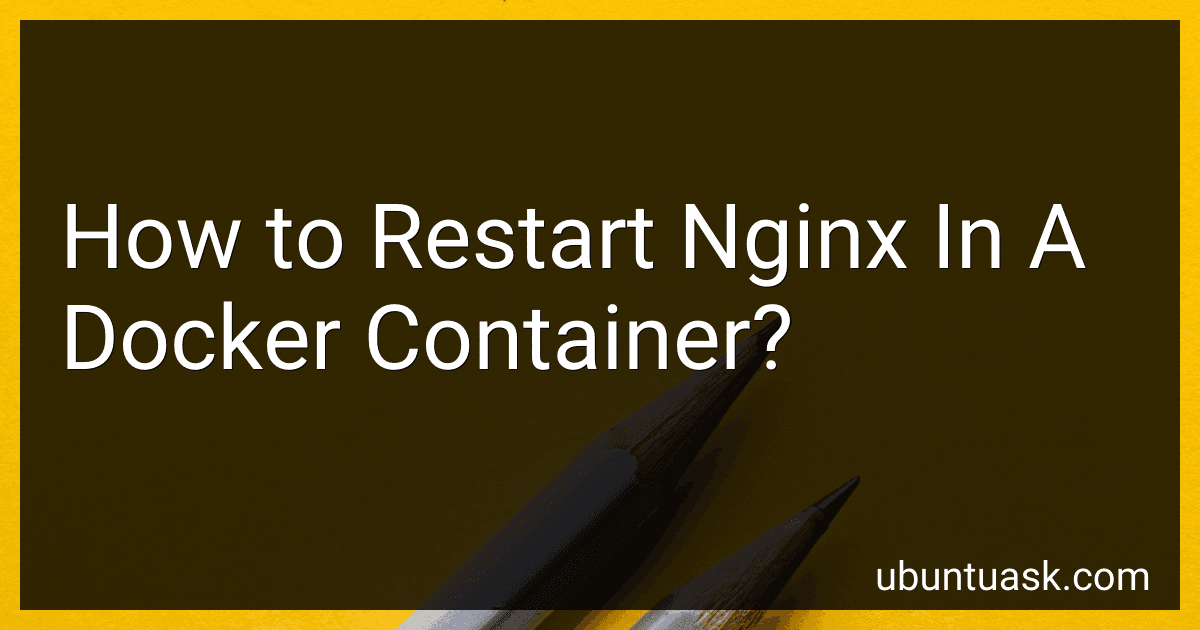Best Tools to Restart Nginx in a Docker Container to Buy in December 2025
To restart Nginx in a Docker container, you can follow these steps:
- Identify the container ID or name of the running Nginx container. You can use the command docker ps to list all running containers and find the specific Nginx container.
- Once you have the container ID or name, use the command docker restart [container_id/container_name], replacing [container_id/container_name] with the actual ID or name of the Nginx container.
- Docker will then initiate the restart process for the container, and Nginx will be restarted within the container.
That's it! Now your Nginx container should be restarted and running again.
How can you troubleshoot issues that may occur during Nginx restarts in a Docker container?
To troubleshoot issues that may occur during Nginx restarts in a Docker container, you can follow these steps:
- Check the container logs: Use the docker logs command to view the logs of the Nginx container. Look for any error messages or warnings that might indicate the cause of the restart issue.
- Verify the Nginx configuration: A misconfigured or invalid configuration file can cause problems during restarts. Ensure that your Nginx configuration is correct by examining the configuration files in the container. The configuration files are usually located in the /etc/nginx directory within the container.
- Test the Nginx configuration: Use the nginx -t command inside the container to test the Nginx configuration file(s) for any syntax errors or configuration issues. If there are any problems, it will let you know the specific file and line number where the error exists.
- Ensure correct file permissions: Check the file permissions and ownership of the Nginx configuration files within the container. Use the ls -l command to verify that the files are readable by the Nginx process. Incorrect permissions can lead to configuration file parsing errors.
- Compare container-specific configurations: Compare the Docker-specific configuration for the Nginx container with a working configuration. Check for any differences in environment variables, volumes, or network configurations that might be causing the issue.
- Check resource limitations: Inadequate hardware resources (e.g., memory, CPU) can cause Nginx restart issues due to out-of-memory errors. Check the resource limitations of the container using the docker stats command and ensure that enough resources are allocated.
- Analyze system logs: Check the system logs of the Docker host machine for any error messages or warnings related to the Nginx container restarts. You can typically find these logs in the /var/log directory of the host machine.
- Review Nginx version and Docker compatibility: Ensure that the version of Nginx you are using is compatible with the version of Docker you are running. Incompatible versions can lead to unexpected behavior and restart issues.
- Use a health check mechanism: Implement a health check mechanism within the Docker container to monitor the Nginx service. This can include scripts or tools that periodically check if Nginx is running and responding correctly, alerting you if it's not.
By following these troubleshooting steps, you can identify and resolve issues that may occur during Nginx restarts in a Docker container.
Can you restart Nginx in a Docker container using a configuration file?
Yes, you can restart Nginx in a Docker container using a configuration file. Here's how you can achieve it:
- Enter the Docker container using the container ID or name: docker exec -it sh
- Once you are inside the container, copy your updated Nginx configuration file to the container's Nginx configuration directory. For example: cp /path/to/your/nginx.conf /etc/nginx/nginx.conf
- Test the configuration file for any syntax errors: nginx -t
- If the configuration file passes the test, you can then safely restart Nginx inside the container using the following command: nginx -s reload
This will gracefully restart Nginx using the new configuration file without dropping any active connections.
How can you monitor the status of Nginx within a Docker container?
Here are a few ways to monitor the status of Nginx within a Docker container:
- Docker Stats: Use the Docker Stats command to view the container's CPU, memory, and network usage in real-time. It provides a basic overview of the container's resource utilization.
- Nginx Status Page: Configure Nginx to enable the status module and expose a status page. You can configure this by adding the following lines to the Nginx configuration file inside the container: location /nginx_status { stub_status on; access_log off; allow 127.0.0.1; # replace with your monitoring server IP deny all; } Then, access the status page using the container IP or domain name, followed by "/nginx_status" (e.g., http://localhost/nginx_status).
- Docker logs: Use the Docker logs command to see the container logs, including Nginx access and error logs. This can help you identify issues or unusual activities within the container.
- Monitoring tools: Utilize monitoring tools like Prometheus, Grafana, or Datadog to track various Nginx metrics like requests per second, latency, response codes, etc. These tools offer advanced monitoring capabilities for analyzing trends, setting up alerts, and creating dashboards.
Consider using a combination of these approaches depending on your monitoring requirements and existing infrastructure setup.
How can you check if Nginx is running in a Docker container?
There are several ways to check if Nginx is running in a Docker container:
- Docker CLI: Use the docker ps command to list all running containers and check if the Nginx container is present. Run the following command: docker ps Look for the container name or ID that corresponds to your Nginx container.
- Docker Logs: Check the logs of the Nginx container using the docker logs command. Run the following command, replacing with the actual name or ID of your Nginx container: docker logs If Nginx is running, you should see its log output.
- HTTP Request: Send an HTTP request to the Nginx container and check if it responds. Run the following command, replacing and with the actual values: curl http://localhost:/ If Nginx is running on the specified port, you should see the response.
- Command Execution: Execute a command within the Nginx container using the docker exec command. Run the following command, replacing with the actual name or ID of your Nginx container: docker exec nginx -v If Nginx is running, it will display the version information.
These methods can help you determine if Nginx is running successfully in a Docker container.
Can you restart multiple Docker containers simultaneously?
Yes, you can restart multiple Docker containers simultaneously by using the Docker CLI (Command Line Interface) or by using a Docker management tool like Docker Compose.
Using Docker CLI:
- Open your terminal or command prompt.
- Run the following command to restart multiple Docker containers simultaneously: docker restart container1 container2 container3 ... Replace "container1", "container2", "container3", etc. with the names or IDs of the containers you want to restart.
Using Docker Compose:
- Open your terminal or command prompt.
- Navigate to the directory where your Docker Compose file is located.
- Run the following command to restart all the containers defined in your Docker Compose file: docker-compose restart This command will restart all the services specified in your Docker Compose file.
By using these methods, you can easily restart multiple Docker containers simultaneously.
How can you kill and remove a Docker container?
To kill and remove a Docker container, you can follow these steps:
- List the running containers using the docker ps command. This will give you a list of all the containers along with their container ID.
- Identify the container you want to kill and remove from the list.
- To stop the running container, use the docker stop command. Replace with the actual container ID obtained from the previous step. This command will send a SIGTERM signal to the main process inside the container, allowing it to gracefully shut down.
- If the container does not stop using the previous command, you can force it to stop using the docker kill command. This will immediately terminate the container and all its processes.
- Once the container is stopped or killed, you can remove it using the docker rm command. This will delete the container and its associated resources.
Note: If the container is part of a Docker compose setup or Docker stack, you may need to use specific commands like docker-compose down or docker stack rm <stack_name> to remove all the associated containers, networks, and volumes.
What command can be used to find the ID of a specific Docker container?
The command "docker ps" can be used to find the ID of a specific Docker container.
Here's how you can use it:
- Open a terminal or command prompt.
- Type "docker ps" and press Enter.
- This command will display a list of all running Docker containers.
- Locate the container you are interested in and find its ID in the first column of the output.
Note that if you want to see all containers (including those that are not currently running), you can use the command "docker ps -a" instead.



